
USS Alcedo (SP-166) was a yacht in the United States Navy. She was the first American vessel lost in World War I.

USS Isabel (SP-521), later PY-10, was a yacht in commission in the United States Navy as a destroyer from 1917 to 1920 and as a patrol yacht from 1921 to 1946.

Kanawha was a 471-ton steam-powered luxury yacht initially built in 1899 for millionaire industrialist and financier Henry Huttleston Rogers (1840–1909). One of the key men in the Standard Oil Trust, Rogers was one of the last of the robber barons of the Gilded Age in the United States.
Six ships of the United States Navy have been named USS Kanawha and one has been named USS Kanawha II:
USS Piqua has been the name of more than one United States Navy ship, and may refer to:

An armed yacht was a yacht that was armed with weapons and was typically in the service of a navy. The word "yacht" was originally applied to small, fast and agile naval vessels suited to piracy and to employment by navies and coast guards against smugglers and pirates. Vessels of this type were adapted to racing by wealthy owners. The origin of civilian yachts as naval vessels, with their speed and maneuverability, made them useful for adaptation to their original function as patrol vessels. In the United States Navy armed yachts were typically private yachts expropriated for government use in times of war. Armed yachts served as patrol vessels during the Spanish–American War and the World Wars. In the latter conflicts, armed yachts were used as patrol vessels, convoy escorts, and in anti-submarine duties. In the United States, yachts were purchased from their owners with the owners given an option to repurchase their yacht at the close of hostilities.

The first USS Vedette (SP-163) was a commercial yacht built in 1899. At the outbreak of World War I, the yacht was leased by the United States Navy, and was used as a section patrol craft in the North Atlantic Ocean. She served honorably during the war, rescuing survivors at sea, and attacking a German U-boat. At war’s end, she was converted to her original configuration and returned to her owner, the railroad executive, financier, and philanthropist Frederick W. Vanderbilt (1856-1938) of New York City.
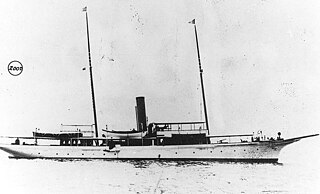
USS Christabel (SP-162) was a civilian steam yacht that was built in Glasgow in 1893 for a Scottish industrialist. She had an American owner by 1910, served as a United States Navy patrol ship in the latter part of the First World War, and afterward was returned to US civilian service.
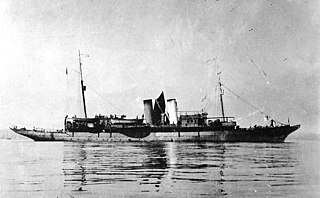
USS Noma (SP-131) was the private steam yacht Noma, built in 1902 on Staten Island and loaned to the U.S. Navy during World War I as a patrol craft assigned to protect shipping from German submarines. At war’s end she served the American Relief Commission in Constantinople and the Black Sea before being returned to her owner after decommissioning. In the 1930s she was converted to a salvage tug, owned in Italy as Salvatore Primo, and torpedoed during World War II.

USS Emeline (SP-175) was a yacht acquired by the U.S. Navy during World War I. She was outfitted with military equipment, including 3-inch guns, and was commissioned as a patrol craft, assigned to protect shipping in the North Atlantic Ocean. She saved the lives of survivors of shipwrecks, and provided escort protection from German submarines for commercial ships. Post-war she was sold to the highest bidder, who had the yacht sail to San Diego, California, for delivery.
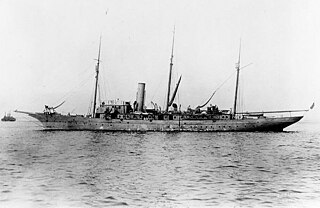
USS Harvard (SP-209) was a yacht leased by the U.S. Navy during World War I. She was outfitted as a patrol craft and assigned to patrol duty in the North Atlantic Ocean, protecting civilian ships from German submarines. In addition, she saved the lives of a number of survivors from ships that had been torpedoed. Post-war she was decommissioned and returned to her owner in her original civilian shipboard configuration.
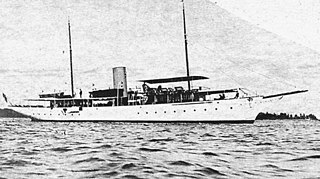
USS Lyndonia (SP-734), later known as USS Vega (SP-734) was a yacht acquired by the U.S. Navy during World War I. She was assigned as an armed patrol craft, but, at times, performed other duties along the U.S. East Coast, such as dispatch boat and training ship for the U.S. Naval Academy. Post-war, she was disposed of through sale to the public.

USS Margaret (ID-2510) – shortly thereafter known as USS Chatham (ID-2510) -- was a cargo ship acquired by the U.S. Navy during World War I. She was used to carry cargo to Allied troops in Europe until the war's end when she was returned to the U.S. Shipping Board for disposition.

USS Wakiva II (SP-160), often referred to as USS Wakiva, was an armed yacht that served in the United States Navy from 1917 to 1918 and saw combat in World War I. She was originally the yacht SS Wakiva II built for Lamon V. Harkness in Scotland.

USS Anderton (SP-530), originally to have been USS Raymond J. Anderton (SP-530), was a patrol vessel and minesweeper that served in the United States Navy from 1917 to 1919.

The third USS Wanderer (SP-132), was an armed yacht that served in the United States Navy from 1917 to 1919.
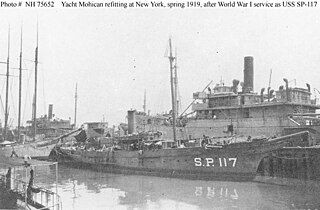
The third USS Mohican (SP-117), later USS SP-117, was an armed yacht that served in the United States Navy as a patrol vessel from 1917 to 1919.

Aphrodite was a yacht built to requirements by owner Colonel Oliver H. Payne of New York City as an ocean going steam yacht with barque rig and capable of good speed under sail alone. The yacht was launched 1 December 1898 and completed in 1899 to be the largest American built steam yacht at the time. The yacht served in the United States Navy as the patrol vessel USS Aphrodite from May 1917 to July 1919. The yacht was given the designation SP-135 for Section patrol and was, unlike the majority of section patrol vessels, sent overseas rather than acting in that capacity in home waters. The yacht was returned to private service after the war.

The first USS Guinevere (SP-512) was a United States Navy patrol vessel in commission from 1917 to 1918.

USS Venetia (SP-431) was a large 589 gross ton steam yacht leased by the U.S. Navy during World War I. She was heavily armed with four 3-inch (76 mm) guns and depth charges, and was assigned duties of a patrol craft, escorting ships in convoy on the North Atlantic Ocean, and protecting those ships from German submarine attack. Venetia was awarded a "star of reward" for her antisubmarine work, and mounted the star on her stack. Post-war she was restored to her original civilian configuration, and was returned to her owner.



















